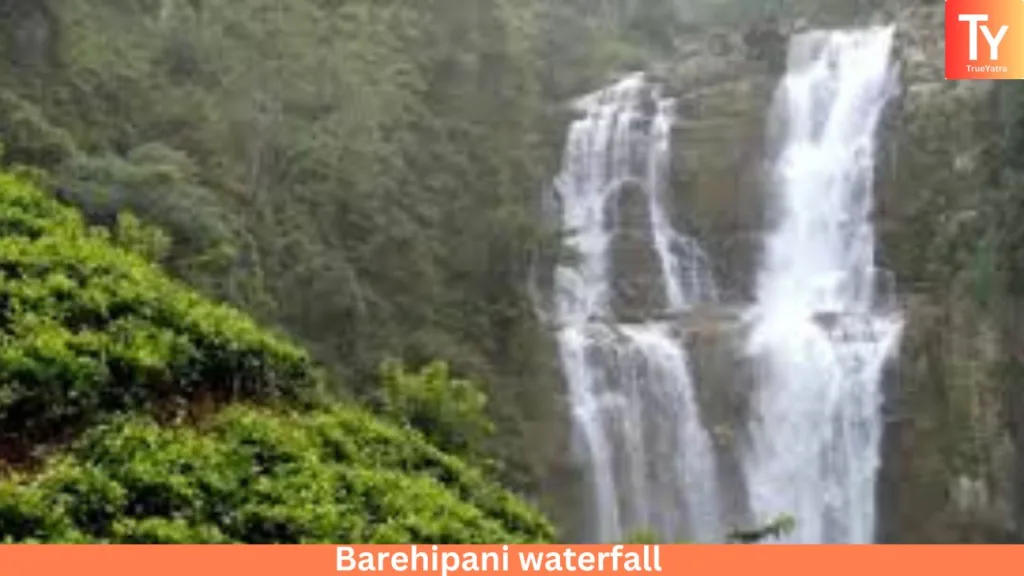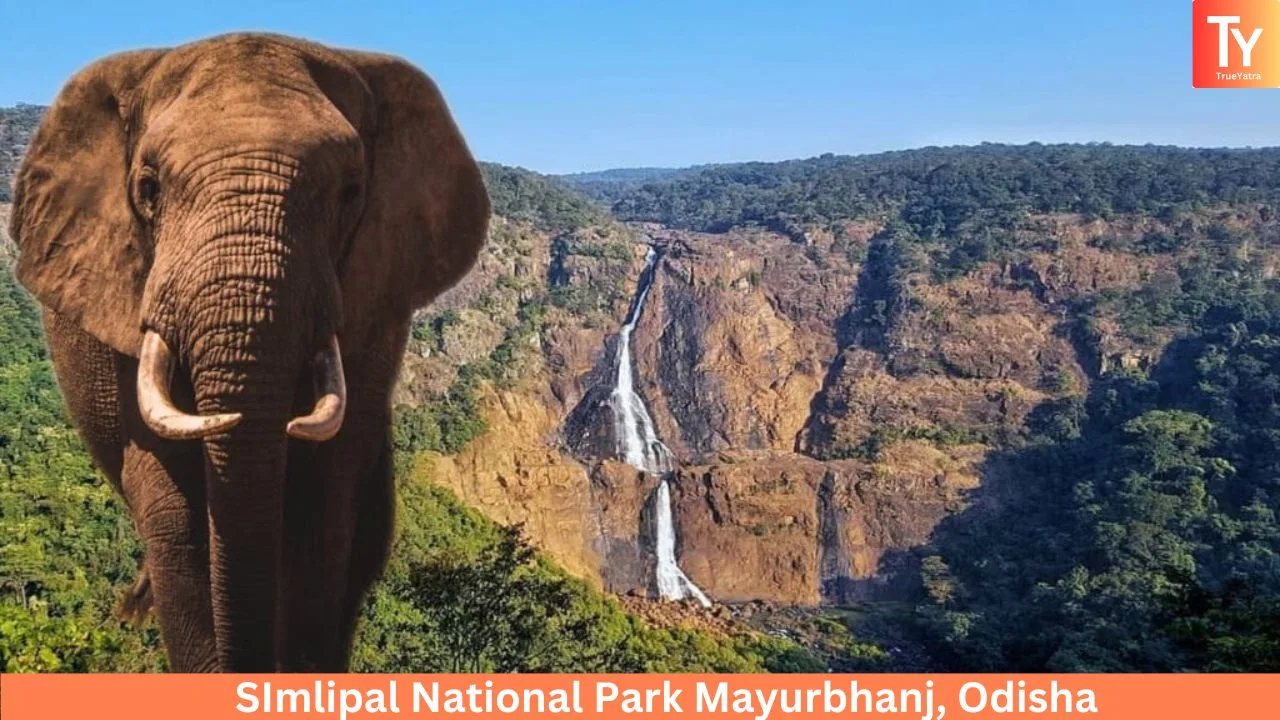Simlipal National Park is located in the Mayurbhanj district in Odisha. Simlipal Park covers an area of 2,750 km sq. This National Park is part of the Mayurbhanj Elephant Reserve, which includes three protected areas—Similipal Tiger Reserve, Hadagarh Wildlife Sanctuary with 191.06 km sq and Kuldiha Wildlife Sanctuary with 272.75 km sq.
Simlipal derives its name from the red silk cotton trees found in abundance in the area. The park is home to Bengal tiger, Asian elephant, Gaur, Chausingha and many other varieties of animals. More than 200 species of birds are found here. The Barehipani Falls at a height of 217 m and the Joranda Falls at 181 m are the main waterfall found in this park and Khairiburu (1,178 m) and Meghasani (1,158 m) are the peaks located in this National Park.
History of Simlipal National Park
The Simlipal elephant reserve was a hunting ground for royals in history. It was designated as a tiger reserve in 1956 and under Project Tiger in May 1973.
Park was declared as a wildlife sanctuary in 1979 by the Government of India. In 1986, the area of the national park was increased to 845.70 square kilometers and was declared as a biosphere reserve in 1994 by the Government of India.
UNESCO added Simlipal national park to the list of World Network of Biosphere Reserves in May 2009. More than 10,000 people are surviving in the 61 villages located in the forest area of the Simlipal National Park.
Simlipal national park in India map | Location
The Park or tiger reserve is located in Mayurbhanj district in Odisha. It is an ecosystem surrounded with forest vegetation mainly including Sal trees, fauna, and Santhal tribal settlements.
Meghasani/Tunkiburu hill (1165 meters) is the highest peak of the national park and Khairiburu (1,000 meters) are two major hills of the Simlipal National Park. About 12 rivers cross the plain area of Simlipal National Park. Some of the major rivers include Budhabalanga and Palpala Bhandan. Two main waterfalls, Joranda at 181 meters and Barheipani at 217 meters are also located in the core area of National Park.
Climate
The climate of Simlipal National Park is moderate. During summer, people experience hot temperatures reaching around 40 °C. Summer remains from March to May whereas the winter season is pleasant and temperature reaches below 14 °C. Winter season lasts from November till February and the rainfall ranges from moderate to heavy during the month of June to September.
Simlipal national park photos

Best time to visit
Best time to visit Simlipal National Park is during Winter season. It is the most ideal time to visit Simlipal since the weather remains pleasant and cool throughout the season. The temperature reaches around 14⁰C and the overall climate during winter is best for observing the different varieties of flora and fauna in their natural habitat.
Thousands of tourists visit Simlipal National Park every year to enjoy the natural beauty of the park.
Simlipal national park is famous for which animal
Simlipal National Park is the safest place for a huge amount of wildlife for their better habitation and protection. The park is home to the royal Bengal tiger. Some of the wildlife are Leopard, Gaur, Elephant, Langur, Barking and Spotted Deer, Sloth Bear Mongoose, Flying Squirrel, Porcupine, Turtle, Monitor Lizard, Python, Sambar, Pangolin, Crocodile and Four horned Antelope. More than 200 species of birds like the Grey Hornbill, Crested Serpent Eagle, Alexandrine Parakeet, Hill Mynah, Red Jungle Fowl, Indian Pied Hornbill, Malabar Pied Hornbill, Indian Trogon, are found in this park.
This National Park is also home to a large number of reptiles including snakes and turtles. Some of the other attractions of the Simlipal National Park are Mugger crocodiles at Jashipur and Barehipani waterfall and Joranda waterfalls.
Major attractions of Simlipal National Park
Jaranda Falls
Joranda Falls is located in the center of the Simlipal National Park in Mayurbhanj district of Orissa. Total height of Jaranda Fall is about 150 meters (490 ft). It is the 19th highest waterfall of India. It is located near to Barehipani fall. It is a straight and single drop waterfall. It is one of the major attractions of Simlipal Park. Thousands of tourists visit this fall every year to enjoy the beauty of the waterfall.
Barehipani fall
Barehipani waterfall is the 2nd highest waterfall of India and highest waterfall of Odisha. The height of the waterfall is 217 m or 1309 feets. Budhabalanga River is the source of this waterfall that flows over the mountain. The fall is located in Simlipal National Park in Mayurbhanj district of odisha. Barehipani Waterfall is considered as one of the major attractions of Odisha
Activities to do at Simlipal National Park
- Exploring the beautiful view of the forest by riding on a safari.
- Watching over more than 200 species of birds.
- Picnics with family or friends.
- Exploring the variety of flora and fauna found in the forest.
- Trekking
- Enjoying the waterfall.
- Interacting with the tribals or villagers surviving in the forest area.
Simlipal national park hotels
There are lots of hotels, resorts or rest houses available near Simlipal for tourists to stay. Some of them are the following
- Aranya Nivas Lulung
- Sitakund forest Resort
- Heaven view Similipal Prakurti Nivas
- Simlipal Eco cottage
Safaris
Enjoying the beautiful natural view of Simlipal National Park, by jeep safari is one of the major attractions for tourists. Jeep safari is a four wheeler vehicle, available for visitors, by the jungle authority used for rides to enjoy the park. The park is one of the major tourist attractions of Odisha. You can enjoy the park by watching the various species of birds, Nature walking, tour of the tribal village and visiting the two beautiful Waterfalls .
How to reach Simlipal National Park
Simlipal National Park is located in Mayurbhanj district of odisha. You can
reach Simlipal National park through various means of transport from any part of the country. It is well connected to other cities of odisha by well constructed roads. Balasore Railway station is the nearest railway station and Biju Patnaik International Airport is the nearest airport located to the park.
By air
Biju Patnaik International Airport in Bhubaneswar is the nearest airport from Mayurbhanj district which is located around 270 km from Simlipal. This airport connects odisha with other major cities of the country easily. At Bhubaneswar many buses are available for every part of Odisha. You can also book a cab or taxi at the airport for Simlipal National Park.
By Rail
Balasore Railway station is the nearest railway station, which is located at a distance of around 76 km from Simlipal National Park. Balasore railway is well connected with other parts of odisha by various trains. At the station, you can book a taxi or cab to reach Simlipal National Park.
By Road
Simlipal National Park is well connected by various other cities of Odisha through well constructed roads. You can easily reach the park by buses or taxi or cab through Road.
Frequently Asked Questions
Where is Simlipal National Park located ?
The Simlipal National Park or tiger reserve is located in Mayurbhanj district in Odisha.
Which is the nearest airport to Simlipal National Park?
Biju Patnaik International Airport, Bhubaneswar is the nearest airport to Simlipal National Park located at a distance of about 270 km from the park.
What are some of the major attractions of Simlipal National Park?
Joranda Falls, Barehipani waterfall, Sitakund waterfall, Mugger Crocodile, and bird watching are some of the major attractions of Simlipal National Park.
What is the best time to visit Simlipal National Park?
Winter is the most ideal time to visit Simlipal since the weather remains pleasant and cool throughout the season. The temperature reaches around 14⁰C and the overall climate during winter is best for observing the different varieties of flora and fauna in their natural habitat
How is the climate of Simlipal National Park?
The climate of Simlipal National Park is moderate. During summer, people experience hot temperatures reaching around 40 °C. Summer remains from March to May whereas the winter season is pleasant and temperature reaches below 14 °C. Winter season lasts from November till February. The rainfall ranges from moderate to heavy.
Simlipal national park is located in which state?
This National Park is location in Mayurbhanj District of Odisha.
Simlipal national park is famous for which animal?
The park is home to the royal Bengal tiger. Some of the wildlife are Leopard, Gaur, Elephant, Langur, Barking and Spotted Deer, Sloth Bear Mongoose, Flying Squirrel, Porcupine, Turtle, Monitor Lizard, Python, Sambar, Pangolin, Crocodile and Four horned Antelope. More than 200 species of birds like the Grey Hornbill, Crested Serpent Eagle, Alexandrine Parakeet, Hill Mynah, Red Jungle Fowl, Indian Pied Hornbill, Malabar Pied Hornbill, Indian Trogon, are found in this park.


Simlipal National Park in Odisha, India, is a biodiversity hotspot known for its lush forests, diverse wildlife, and pristine landscapes. Spread over 2,750 square kilometers, it’s home to Royal Bengal Tigers, Asian Elephants, and numerous rare plant species. Simlipal’s beauty and conservation efforts make it a must-visit destination.
Thanks for your feedback Vinay. Will keep you posted for new development in blog.
This blog is very helpful as all the necessary information such that climate , how to visit , airport, railway station,and also the transport provided by them for safari of the reserve .this blog is enough for any ony who wants to know about that place before visiting there . Thank you for giving this great information.
Thanks Snehil for your feedback, We appreciate your efforts for sharing such Good Feedback. Kindly let us know if we you want to know any specific information on any other location which we have not covered.
Simplipal National park has major attractions of waterfalls like Joranda Falls, Barehipani waterfall, Sitakund waterfall. According to me the best time to visit is ending of monsoon and starting of winter, as the environment would be perfect for such a place to visit.
Thanks lokesh for your wonderful feedback. We are committed to deliver the best information on tourism, Temple, Tirth Sthal.